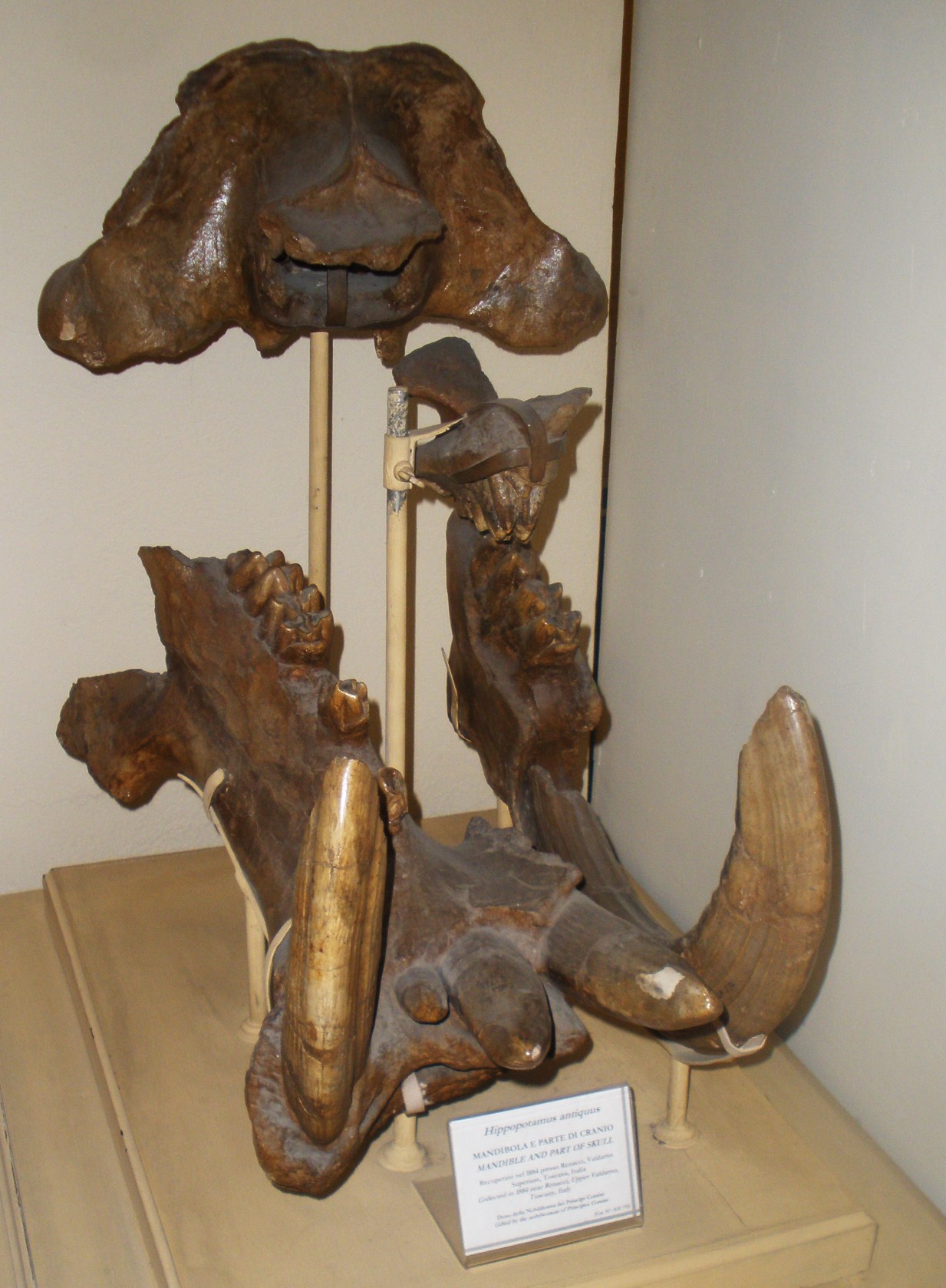Hippopotamus major on:
[Wikipedia]
[Google]
[Amazon]
''Hippopotamus antiquus'', sometimes called the European hippopotamus, is an extinct species of ''
in PDF
Their distribution was strongly controlled by temperature, with the species only extending to the northern parts of Europe during warmer interglacial intervals. At an average weight of 3200 kg (7040 lb), ''Hippopotamus antiquus'' was larger than the modern common hippopotamus (''
At an average weight of 3200 kg (7040 lb), ''Hippopotamus antiquus'' was larger than the modern common hippopotamus (''
PDF fulltext
''Hippopotamus antiquus'' has been suggested to have been less terrestrial than ''Hippopotamus amphibius'', with more elevated eyesockets and shorter
Hippopotamus
The hippopotamus ( ; : hippopotamuses or hippopotami; ''Hippopotamus amphibius''), also called the hippo, common hippopotamus, or river hippopotamus, is a large semiaquatic mammal native to sub-Saharan Africa. It is one of only two extan ...
'' that ranged across Europe
Europe is a large peninsula conventionally considered a continent in its own right because of its great physical size and the weight of its history and traditions. Europe is also considered a subcontinent of Eurasia and it is located entirel ...
during the Early and Middle Pleistocene
The Chibanian, widely known by its previous designation of Middle Pleistocene, is an age in the international geologic timescale or a stage in chronostratigraphy, being a division of the Pleistocene Epoch within the ongoing Quaternary Period. Th ...
.
Chronology
In Italy, the first appearance of the taxon is during the late Early Pleistocene, around 1.2 Ma, remains from Coste San Giacomo, suggested to date to around 2 Ma, have an uncertain stratigraphic context. ''H. antiquus'' first became widespread north of the Alps around 1.1 to 1 million years ago. The youngest confirmed remains of the taxon date toMIS
MIS or mis may refer to:
Science and technology
* Management information system
* Marine isotope stage, stages of the Earth's climate
* Maximal independent set, in graph theory
* Metal-insulator-semiconductor, e.g., in MIS capacitor
* Minimally ...
15, (621–563,000 years ago), but there are possibly later records dating to MIS 11 (424,000 to 374,000 years ago). Later records of ''Hippopotamus
The hippopotamus ( ; : hippopotamuses or hippopotami; ''Hippopotamus amphibius''), also called the hippo, common hippopotamus, or river hippopotamus, is a large semiaquatic mammal native to sub-Saharan Africa. It is one of only two extan ...
'' in continental Europe beginning in MIS 13 (~524,000-474,000 years ago), are believed to belong to the modern hippopotamus
The hippopotamus ( ; : hippopotamuses or hippopotami; ''Hippopotamus amphibius''), also called the hippo, common hippopotamus, or river hippopotamus, is a large semiaquatic mammal native to sub-Saharan Africa. It is one of only two extan ...
(''Hippopotamus amphibius'').
Biology
''H. antiquus'' ranged from theIberian Peninsula
The Iberian Peninsula (),
**
* Aragonese and Occitan: ''Peninsula Iberica''
**
**
* french: Péninsule Ibérique
* mwl, Península Eibérica
* eu, Iberiar penintsula also known as Iberia, is a peninsula in southwestern Europe, def ...
to the British Isles
The British Isles are a group of islands in the North Atlantic Ocean off the north-western coast of continental Europe, consisting of the islands of Great Britain, Ireland, the Isle of Man, the Inner and Outer Hebrides, the Northern Isles, ...
to the Rhine River
), Surselva, Graubünden, Switzerland
, source1_coordinates=
, source1_elevation =
, source2 = Rein Posteriur/Hinterrhein
, source2_location = Paradies Glacier, Graubünden, Switzerland
, source2_coordinates=
, source ...
to Greece
Greece,, or , romanized: ', officially the Hellenic Republic, is a country in Southeast Europe. It is situated on the southern tip of the Balkans, and is located at the crossroads of Europe, Asia, and Africa. Greece shares land borders ...
."150 Years of Neanderthal Discoveries; Early Europeans - Continuity & Discontinuity," ed. von Koenigswald, Wighart and Thomas Litt, TERRA NOSTRA 2006/2 University of Bonn
The Rhenish Friedrich Wilhelm University of Bonn (german: Rheinische Friedrich-Wilhelms-Universität Bonn) is a public research university located in Bonn, North Rhine-Westphalia, Germany. It was founded in its present form as the ( en, Rhine ...
in PDF
Their distribution was strongly controlled by temperature, with the species only extending to the northern parts of Europe during warmer interglacial intervals.
Hippopotamus amphibius
The hippopotamus ( ; : hippopotamuses or hippopotami; ''Hippopotamus amphibius''), also called the hippo, common hippopotamus, or river hippopotamus, is a large semiaquatic mammal native to sub-Saharan Africa. It is one of only two extant ...
''), but smaller than ''Hippopotamus gorgops
''Hippopotamus gorgops'' is an extinct species of hippopotamus. It first appeared in Africa during the late Pliocene, and eventually migrated into Europe (where its fossils were first discovered) during the early Pleistocene. It became extinct du ...
''.Petronio, C. (1995): Note on the taxonomy of Pleistocene hippopotamuses. ''Ibex'' 3: 53-55PDF fulltext
''Hippopotamus antiquus'' has been suggested to have been less terrestrial than ''Hippopotamus amphibius'', with more elevated eyesockets and shorter
metapodial Metapodials are long bones of the hand (metacarpals) and feet (metatarsal
The metatarsal bones, or metatarsus, are a group of five long bones in the foot, located between the tarsal bones of the hind- and mid-foot and the phalanges of the toes ...
bones than ''H. amphibius.'' An analysis of nitrogen isotopes suggests that ''H. antiquus'' preferred aquatic plants, in contrast to modern ''H. amphibius'', which prefers terrestrial grasses.
The Cretan dwarf hippopotamus (''H. creutzburgi'') is believed to have evolved from ''H. antiquus'' through the process of insular dwarfism
Insular dwarfism, a form of phyletic dwarfism, is the process and condition of large animals evolving or having a reduced body size when their population's range is limited to a small environment, primarily islands. This natural process is disti ...
on the island of Crete
Crete ( el, Κρήτη, translit=, Modern: , Ancient: ) is the largest and most populous of the Greek islands, the 88th largest island in the world and the fifth largest island in the Mediterranean Sea, after Sicily, Sardinia, Cyprus, ...
.
References
Extinct hippopotamuses Pleistocene even-toed ungulates Prehistoric mammals of Europe Fossil taxa described in 1822 {{paleo-eventoedungulate-stub